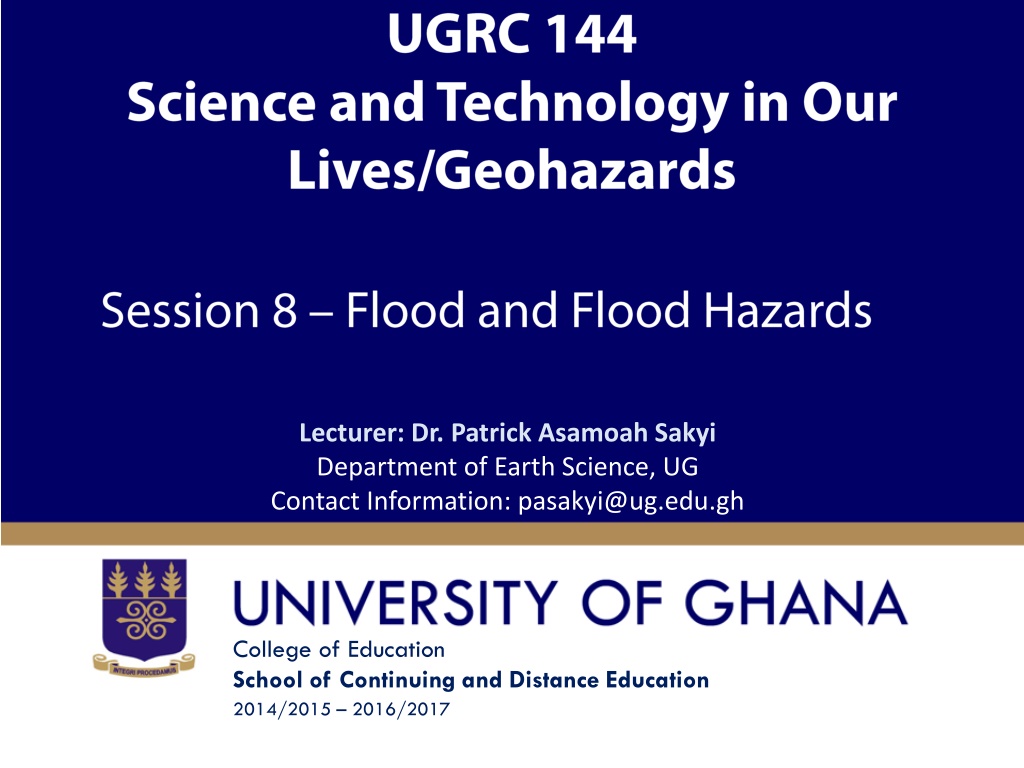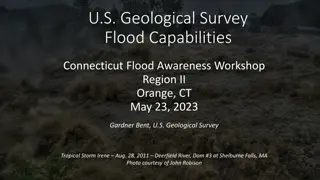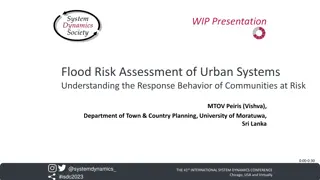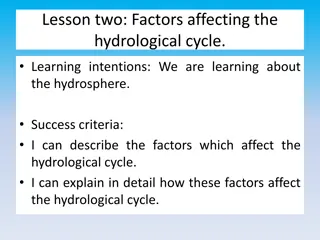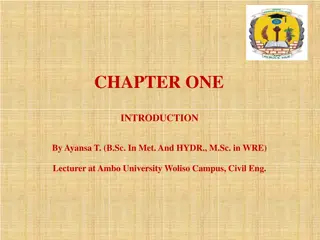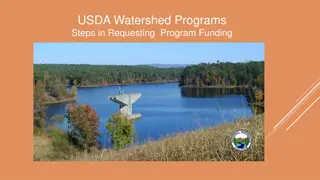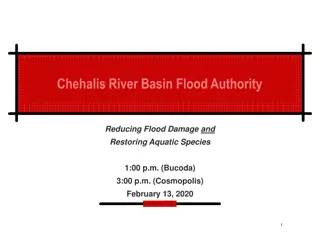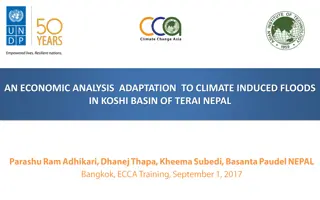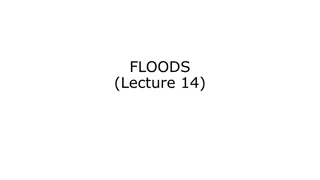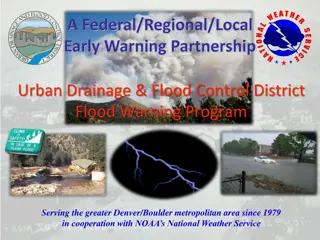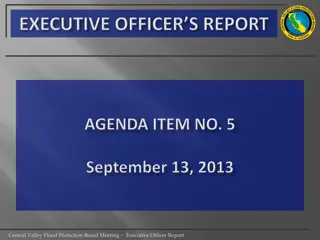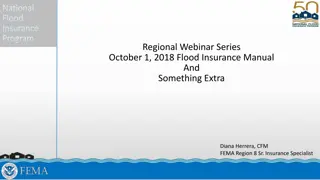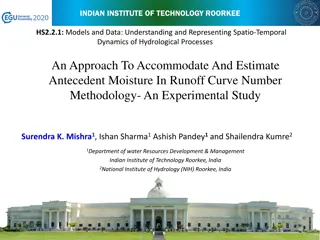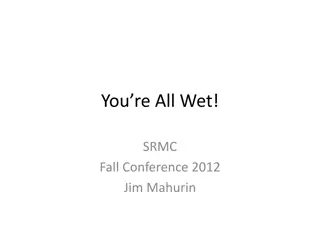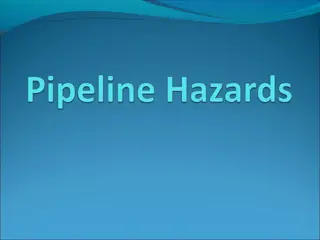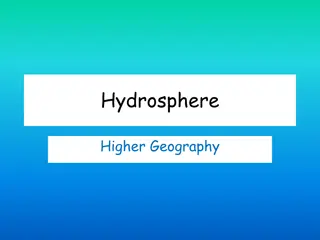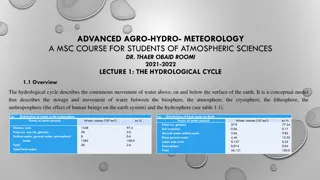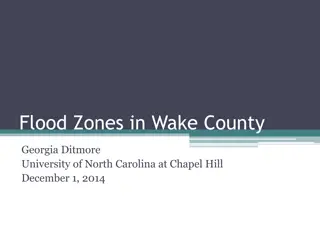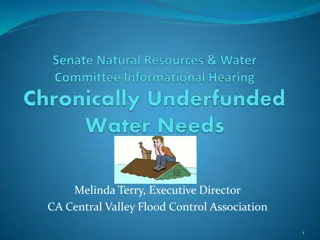Understanding the Hydrological Cycle and Flood Hazards
This session with Dr. Patrick Asamoah Sakyi delves into the hydrologic cycle, causes of flooding, and ways to mitigate flood hazards. Topics covered include the hydrologic cycle, stream systems, flood consequences, factors affecting flood severity, and strategies for reducing flood risks. Recommended reading materials offer further insights into environmental geology and geohazards.
Download Presentation

Please find below an Image/Link to download the presentation.
The content on the website is provided AS IS for your information and personal use only. It may not be sold, licensed, or shared on other websites without obtaining consent from the author. Download presentation by click this link. If you encounter any issues during the download, it is possible that the publisher has removed the file from their server.
E N D
Presentation Transcript
Lecturer: Dr. Patrick Asamoah Sakyi Department of Earth Science, UG Contact Information: pasakyi@ug.edu.gh College of Education School of Continuing and Distance Education 2014/2015 2016/2017
Session Overview This session looks at the hydrologic cycle and the major causes of flooding. We shall look at the some of the activities that lead to the development of flood hazards and the effects of floods on the environment. We shall also discuss the various approaches to reduce the hazardous impact of floods on life and property Slide 2 Dr. Patrick A. Sakyi, Dept. of Earth Science
Session Outline The key topics to be covered in the session are as follows: Topic One The Hydrologic Cycle Topic Two Streams Systems and their Features Topic Three Flooding: Consequence and Development of Floodplains Topic Four Factors Governing Flood Severity Topic Five Flood Characteristics Topic Six - Effects of Development on Flood Hazards Topic Seven - Hazards Associated with Floods Topic Eight - Strategies for Reducing Flood Hazards Slide 3 Dr. Patrick A. Sakyi, Dept. of Earth Science
Reading List Chapter 6 of Environmental Geology 4th Edition, Wm. C. Brown Publishers by Carla W Montgomery (1995) Chapter 14 of Physical Geology. 3rd Edition. Wm. C. Brown Publishers by Carla W Montgomery. (1993). Chapter 7 of Environmental Geology. Second Edition. Prentice Hall. Lungren, L. W. (1999). Unit 2, Sections 3 & 4 of UGRC 140 II Geohazards Institute of Continuing and Distance Education. Slide 4 Dr. Patrick A. Sakyi, Dept. of Earth Science
Topic One THE HYDROLOGIC CYCLE Slide 5 Dr. Patrick A. Sakyi, Dept. of Earth Science
The Hydrologic Cycle The hydrosphere includes all the water at and near the surface of the earth. All the water in the hydrosphere is caught up in the hydrological Precipitation The hydrologic cycle begins with precipitation in the form of snow or rain, representing the initial input into the hydrologic system. Slide 6 Dr. Patrick A. Sakyi, Dept. of Earth Science
The Hydrologic Cycle Evapotranspiration A fraction of the precipitation is returned to the atmosphere by two processes; Evaporation, driven by solar energy, is the physical conversion of some of the precipitation to water vapour that is returned to the local atmosphere. Plant Transpiration is the process by which plants release water into the atmosphere Slide 7 Dr. Patrick A. Sakyi, Dept. of Earth Science
The Hydrologic Cycle Surface Runoff The runoff tends to move toward sinks or temporary storage locations such as; streams/rivers Lakes Wetlands the ocean The runoff fraction is a major factor leading to river flooding. Slide 8 Dr. Patrick A. Sakyi, Dept. of Earth Science
The Hydrologic Cycle Infiltration A fraction of the precipitation moves down into the ground, and infiltrate into the regolith in the subsurface. Unsaturated Zone: the upper part of the regolith in which the pore spaces of the rock/soil is partially filled with air and partly with water. Saturated Zone: this is the zone between the base of the unsaturated zone and an impermeable rock below, within which water accumulates. Slide 9 Dr. Patrick A. Sakyi, Dept. of Earth Science
The Hydrologic Cycle Infiltration A fraction of the precipitation moves down into the ground, and infiltrate into the regolith in the subsurface. Unsaturated Zone: the upper part of the regolith in which the pore spaces of the rock/soil is partially filled with air and partly with water. Saturated Zone: this is the zone between the base of the unsaturated zone and an impermeable rock below, within which water accumulates. Unsaturated zone Saturated zone Slide 10 Dr. Patrick A. Sakyi, Dept. of Earth Science
Topic Two STREAMS SYSTEMS AND THEIR FEATURES Slide 11 Dr. Patrick A. Sakyi, Dept. of Earth Science
Streams Systems and their Features A stream is body of flowing water confined within a channel, regardless of size. It flows downhill through local topographic lows, carrying away water over the earth s surface In addition to that, the size of a stream is influenced by the following factors climate, including the amount of precipitation and evaporation vegetation or lack of it the underlying geology Dr. Patrick A. Sakyi, Dept. of Earth Science Slide 12
Streams Systems and their Features Importance of Streams Streams are a major source of water and transportation for the world's human population. They carry billions of tons of sediment to lower elevations, and thus are one of the main transporting mediums in the production of sedimentary rocks. Streams are sources of water for consumption, agriculture, and industry. Streams are also used to generate hydroelectric power, just like what we have at Akosombo, Akuse, and Bui in Ghana. Slide 13 Dr. Patrick A. Sakyi, Dept. of Earth Science
Topic Three FLOODING: CONSEQUENCE AND DEVELOPMENT OF FLOODPLAINS Slide 14 Dr. Patrick A. Sakyi, Dept. of Earth Science
Flooding: Consequence and Development of Floodplains Large volumes of water flowing in streams often lead to flooding, and flooding is one of the more common and costly types of natural disasters. The over flow of a streams banks due to higher discharge is termed flood. Flood occurs when a stream runs out of its confines and submerges surrounding areas. Slide 15 Dr. Patrick A. Sakyi, Dept. of Earth Science
Flooding: Consequence and Development of Floodplains A majority of stream floods are linked to precipitation. When rainfalls or snow melts, some of the water infiltrates or sinks into the ground. It may then percolate through soil and rock at greater depths. Slide 16 Dr. Patrick A. Sakyi, Dept. of Earth Science
Topic Four FACTORS GOVERNING FLOOD SEVERITY Slide 17 Dr. Patrick A. Sakyi, Dept. of Earth Science
Factors Governing Flood Severity The factors that govern flood severity are as follows; Role of Precipitation If there is exceptional precipitation, the subsurface is not able to absorb all the water because precipitation intensity is higher than infiltration rate into the ground If this happens over a prolong period, there is gradual build up of large volumes of water on the surface of the earth, and could lead to flooding. If the amount of water flowing in to one area is greater than the capacity of the system to hold it within natural confines, it will result is a flood. Slide 18 Dr. Patrick A. Sakyi, Dept. of Earth Science
Factors Governing Flood Severity The factors that govern flood severity are as follows; Dam & Levee Failures Dams occur as both natural and human constructed features. Natural dams are created by volcanic events through lava flows and pyroclastic flows, landslides, or blockage by ice. Human-constructed dams are built for water storage, generation of electrical power, and flood control. All types of dams may fail with the sudden release of water into the downstream drainage. Slide 19 Dr. Patrick A. Sakyi, Dept. of Earth Science
Factors Governing Flood Severity The factors that govern flood severity are as follows; Porosity and permeability of the underlying rock A very porous and permeable soil allows a great deal of water to sink in relatively fast. If the soil is less permeable or is covered by artificial structures, the proportion of water that runs off over the surface increases. Once saturated with water, any additional moisture is necessarily forced to become part of the surface runoff. Slide 20 Dr. Patrick A. Sakyi, Dept. of Earth Science
Factors Governing Flood Severity The factors that govern flood severity are as follows; Topography The steeper the terrain, the more readily water will runoff over the surface and the less it tends to sink into the soil. Water that infiltrates the soil tends to flow down gradient and may in time, also reaches the stream. The more gradually the water reaches the stream, the better the chances that the stream discharge will be adequate to carry the water away without flooding. Slide 21 Dr. Patrick A. Sakyi, Dept. of Earth Science
Factors Governing Flood Severity The factors that govern flood severity are as follows; Vegetation Vegetation may reduce flood hazards in many ways. The plants may simply provide physical barrier to surface runoff, decreasing its velocity, and thus slowing the rate at which water reaches a stream. Also plant roots loosen the soil and tend to maintain or increase infiltration. Plants also absorb water, using some to grow. Thus, vegetation can be critical to preventing soil erosion. Slide 22 Dr. Patrick A. Sakyi, Dept. of Earth Science
Topic Five FLOOD CHARACTERISTICS Slide 23 Dr. Patrick A. Sakyi, Dept. of Earth Science
Flood Characteristics During a flood, the water level of a stream is higher than usual, and its velocity and discharge also increases as the greater mass of water is pulled down by gravity. The elevation of the water at any point is termed the stage of the stream. A stream is at flood stage when the stream stage exceeds bank height. Slide 24 Dr. Patrick A. Sakyi, Dept. of Earth Science
Flood Characteristics Upstream floods are floods that affect only small localized areas (streams draining small basins). They are caused by sudden, locally intense rainstorms and by events like dam failure. Downstream floods are floods that affect large stream systems and large drainage basins. They result from prolonged heavy rains over a broad area or from extensive regional snowmelt. Slide 25 Dr. Patrick A. Sakyi, Dept. of Earth Science
Topic Six EFFECTS OF DEVELOPMENT ON FLOOD HAZARDS Slide 26 Dr. Patrick A. Sakyi, Dept. of Earth Science
Effects of Development on Flood Hazards Floods are normally caused by one or a combination of the following activities and processes; Materials used to cover the ground when cities are built, such as roads asphalt and concrete, are relatively impermeable and greatly reduce infiltration. Buildings in a floodplain also can increase flood heights. The buildings block the original river channel and occupy volume that water formally could fill, and a give discharge corresponding to a higher water level Slide 27 Dr. Patrick A. Sakyi, Dept. of Earth Science
Effects of Development on Flood Hazards Both farming and urbanization also disturb the land, by removing natural vegetation, and expose the soil to erosion. Indiscriminate dumping of garbage and other solid materials into drains impede the flow of water. It is also common to observe drains that have experienced siltation, where silt- and sand-sized particles settle in the drains, and subsequently reducing its volume. Slide 28 Dr. Patrick A. Sakyi, Dept. of Earth Science
Topic Seven HAZARDS ASSOCIATED WITH FLOODS Slide 29 Dr. Patrick A. Sakyi, Dept. of Earth Science
Hazards Associated with Floods Primary effects of flooding include; injury, loss of life, and damage caused by swift currents, debris and sediment transported to farms, Destruction of homes, building, railroads, roads, bridges Damage to urban communication and supply systems. Slide 30 Dr. Patrick A. Sakyi, Dept. of Earth Science
Hazards Associated with Floods Secondary effects may include; short-term pollution of rivers, hunger and disease, and displacement of persons who have lost their homes. In addition, fires may be caused by cuts in electrical circuits or gas mains broken by flooding and associated erosion. Slide 31 Dr. Patrick A. Sakyi, Dept. of Earth Science
Topic Eight STRATEGIES FOR REDUCING FLOOD HAZARDS Slide 32 Dr. Patrick A. Sakyi, Dept. of Earth Science
Strategies for Reducing Flood Hazards 1. Restrictive Zoning and Flood proofing This involves the identification of an area threatened by floods of different recurrence intervals. Once this is done, the land might best be restricted to land uses not involving much building. 2. Channelization This refers to the modification of a stream channel itself intended to increase the velocity of water or volume of the channel, or both. Slide 33 Dr. Patrick A. Sakyi, Dept. of Earth Science
Strategies for Reducing Flood Hazards 3. Retention Ponds and Diversion Channels The ponds are large basins that trap some of the surface runoff, keeping it from flowing immediately into the stream. Diversion channels come into play as the water level in streams rises. The channels are used to redirect some of the water flow into areas adjacent to the stream where flooding will cause minimal damage. Slide 34 Dr. Patrick A. Sakyi, Dept. of Earth Science
Strategies for Reducing Flood Hazards 4. Levees These are raised banks along a stream channel. 5. Construction of Flood-Control Dams and Reservoirs 6. Removal of waterweeds, garbage and other obstacles that block the drains and prevent free flow of water Slide 35 Dr. Patrick A. Sakyi, Dept. of Earth Science
Summary In this session, we learnt that the hydrologic cycle includes subsystems such as precipitation, evapotranspiration, infiltration and surface runoff. Runoff could eventually end up in a river, representing a body of flowing water confined within a channel. Flooding is the normal response of a river to an unusually high input of water, in the form of precipitation, in a short time. Failures of dams and levees result the sudden release of water into the downstream drainage, causing flooding to occur. Slide 36 Dr. Patrick A. Sakyi, Dept. of Earth Science
END Slide 37 Dr. Patrick A. Sakyi, Dept. of Earth Science
